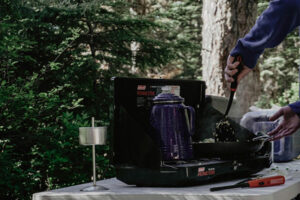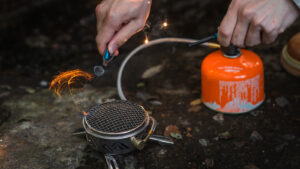
The right canoe camping stove should be trustworthy and effective. Factors such as the type of fuel, storage, and performance in the wind are paramount. Propane stoves have been known to provide consistent heat output besides being easy to use. Canister stoves also serve as lightweight and compact alternatives, especially when hiking or paddling long distances.
We shall discuss the pros and cons of each type. Additionally, we will give some guidelines on how to safely store your camp stove in a canoe.
Propane vs Canister Canoe Camping Stove – Pros and Cons
Propane Canoe Camping Stoves: Pros
- Even Heating: The constancy in the quantity of heat offered by propane devices is one of their advantages. This is needed to enable fast cooking under unforeseen climatic conditions when preparing meals.
- Ease of Use: These are easy-to-use gadgets that require attaching the cylinder before starting to cook.
- Fuel Availability: With propane canisters being found in nearly every shop, it becomes easy for anyone in transit to find fuel for his or her stove.
- Affordability: Over time, propane stoves may be more practical, especially when making long trips, since propane gas tends to be cheaper.
Propane Canoe Camping Stoves Cons:
- Large Size: When you decide to pack your canoe, remember that such tanks will occupy more space than cans with gas inside them and will also be heavier.
- Storage Challenge: To avoid any injuries related to heavy-weight containers, safely storing these tanks in a canoe requires close attention from adventurers.
Canister Canoe Camping Stoves: Pros
- Tiny and lightweight: For campers who value minimalism, canister stoves are the best choice. Moreover, they do not occupy much space and are easier to carry, making them suitable for canoe camping.
- Easy Setup: Setting up a canister stove is quick and easy. You only need to attach the canister, light up a fire, and you are ready to cook.
- Adaptable: Many canister stoves work well in different conditions, including those at high altitudes, making them flexible for different environments.
- Stable Flame: The controlled flame of the gas cartridge stove is vital when making meals under windy circumstances.
Cons:
- Lack of Fuel Supply: In comparison with propane, there may not be as many fuel cans available. It is important to stock up on fuel cans before traveling to remote areas.
- Higher Price: Eventually, buying a fuel can for the stove may be more expensive than propane over time.
- Less Effective during Cold Weather: If it gets really cold outside, it would be hard for any canister stove to function well since the fuel cartridges may perform less effectively compared with propane.
Whether you choose propane or a canister-style stove depends on your personal preferences or individual needs. Propane stoves offer consistent heating along with ease of use, which makes them an ideal choice if these factors matter most to you.
 How to Safely Store a Camping Stoves in a Canoe
How to Safely Store a Camping Stoves in a Canoe
If you want to have a tiring-free experience during your camping trip, then it is of utmost importance that you store the camp stove in a canoe correctly. Here are practical tips for ensuring that your stove remains safe as well as keeping your journey secure.
- Waterproof Bag: Put your stove into a waterproof dry bag; this will prevent water damage and keep all the pieces together.
- Tie with Straps: Use adjustable straps or bungee cords to hold the stove on the canoe. Make sure it is tightly fastened so there is no movement while paddling.
- Stay Clear of Sharp Objects: Keep away from sharp objects that might penetrate the fuel canister or cause damage.
- Divide Fuel: Store fuel canisters individually in an upright position in a well-ventilated space to prevent leaks and ease access.
- Stove Case: Where possible, use a hard or padded case for added protection against impacts and rough handling, such as dropping.
By following these steps, your camp stove will be safely stored and ready for use, whereas your camping trips on canoes will be seamless and enjoyable.
Best Canoe Camping Stoves for Windy Conditions
To succeed in canoe camping, it is important to get the right stove for windy conditions. Wind can make cooking difficult, but an appropriate kitchenette would save the situation.
MSR WindBurner Stove System:
This stove has been created to withstand high winds. A jet that is enclosed and a windscreen built creates a steady flame, which makes it ideal for breezy days.
Jetboil Flash Cooking System:
Known for its efficiency, Jetboil Flash boils water quickly even under windy conditions. This wind-resistant and compact choice would be awesome for canoe camping too.
Primus Tupike Stove:
The portability of this stove combines with its excellent resistance to wind. Side panels that protect from gusts of air are available, as is a stable platform that will ensure safe and efficient cooking.
Coleman PowerPack Propane Stove:
It’s good for windy weather due to its powerful burner and windshields that block it out. Moreover, it’s very easy to use and carry around.
Selecting such stoves will enable you to cook your meals regardless of the prevailing weather so that you can enjoy your canoe camping experience more efficiently.
 Conclusion Camping Stoves:
Conclusion Camping Stoves:
One needs to choose the correct stove for canoe camping, which is very important in order to have a successful outdoor adventure. These are such that they burn propane, and this guarantees a constant heat supply as well as ease of use, which makes them quite efficient in different conditions.
Canister stoves are lightweight and small, whereas those who want something that is portable should go for them. There are advantages and disadvantages to each type, ranging from the availability of fuel to how they perform during windy periods.
By properly storing your stove inside your canoe, you can ensure your trip is going without any complications by taking into consideration the wind direction at the moment when you buy it. The knowledge of these things will aid you in making better choices and improve your experience when camping with a canoe.

 How to Safely Store a Camping Stoves in a Canoe
How to Safely Store a Camping Stoves in a Canoe Conclusion Camping Stoves:
Conclusion Camping Stoves:







